Soil Organic Carbon Prediction Based on Vis–NIR Spectral Classification Data Using GWPCA–FCM Algorithm
Abstract
:1. Introduction
2. Materials and Methods
2.1. Study Area
2.2. Soil Sampling and Spectra Measurement
2.3. Spectral Data Preprocessing
2.4. GWPCA
2.5. Spectral Classification Methods
2.6. Model Construction and Evaluation
2.7. Important Band Analysis
3. Results and Discussion
3.1. Statistical Analysis of SOC Content
3.2. Spectra Classification and SOC Content
3.3. Spectral Characteristics of Different Soil Types
3.4. Spectral Prediction of SOC
3.5. Important Band of SOC for Each Soil Type in RF Models
4. Conclusions
Author Contributions
Funding
Institutional Review Board Statement
Informed Consent Statement
Data Availability Statement
Conflicts of Interest
References
- Lu, H.B.; Wang, X.Y.; Zhang, H.C.; Xie, X.H.; Nakhavali, M.; Quine, T.A.; Xu, W.F.; Xia, J.Z.; He, B.; Hao, Z.X.; et al. Soil Organic Carbon Lateral Movement Processes Integrated into a Terrestrial Ecosystem Model. J. Adv. Model. Earth Syst. 2024, 16, e2023MS003916. [Google Scholar] [CrossRef]
- Stockmann, U.; Padarian, J.; McBratney, A.; Minasny, B.; de Brogniez, D.; Montanarella, L.; Hong, S.Y.; Rawlins, B.G.; Field, D.J. Global soil organic carbon assessment. Glob. Food Secur.-Agric. Policy 2015, 6, 9–16. [Google Scholar] [CrossRef]
- Yousra, M.; Hussain, Q.; Khan, K.S.; Ansar, M.; Sarwar, S.; Khan, M.Z. Soil Organic Carbon Pools in Benchmark Soils of Punjab, Pakistan. Commun. Soil Sci. Plant Anal. 2023, 54, 571–585. [Google Scholar] [CrossRef]
- Araújo, S.R.; Wetterlind, J.; Demattê, J.A.M.; Stenberg, B. Improving the prediction performance of a large tropical vis-NIR spectroscopic soil library from Brazil by clustering into smaller subsets or use of data mining calibration techniques. Eur. J. Soil Sci. 2014, 65, 718–729. [Google Scholar] [CrossRef]
- Viscarra Rossel, R.A.; Behrens, T.; Ben-Dor, E.; Brown, D.J.; Demattê, J.A.M.; Shepherd, K.D.; Shi, Z.; Stenberg, B.; Stevens, A.; Adamchuk, V.; et al. A global spectral library to characterize the world’s soil. Earth-Sci. Rev. 2016, 155, 198–230. [Google Scholar] [CrossRef]
- Meng, X.T.; Bao, Y.L.; Zhang, X.L.; Wang, X.; Liu, H.J. Prediction of soil organic matter using different soil classification hierarchical level stratification strategies and spectral characteristic parameters. Geoderma 2022, 411, 115696. [Google Scholar] [CrossRef]
- Ding, S.T.; Zhang, X.; Shang, K.; Xiao, Q.; Wang, W.H.; Rehman, A.U.R. Removal of environmental influences for estimating soil texture fractions based on ZY1 satellite hyperspectral images. Catena 2024, 236, 107713. [Google Scholar] [CrossRef]
- Hou, M.J.; Ai, Z.M.; Li, X.H.; Dang, X.H.; Yao, Y.Y.; Deng, Y.; Wang, T.; Li, T.; Xiao, L. Exploring the optimal model for assessing SOC and TN in Zanthoxylum bungeanum forest on the Loess Plateau using VNIR spectroscopy. Ecol. Inform. 2024, 79, 102429. [Google Scholar] [CrossRef]
- Omondiagbe, O.P.; Lilburne, L.; Licorish, S.A.; MacDonell, S.G. Soil texture prediction with automated deep convolutional neural networks and population-based learning. Geoderma 2023, 436, 116521. [Google Scholar] [CrossRef]
- Shi, Z.; Wang, Q.L.; Peng, J.; Ji, W.J.; Liu, H.J.; Li, X.; Viscarra Rossel, R.A. Development of a national VNIR soil-spectral library for soil classification and prediction of organic matter concentrations. Sci. China-Earth Sci. 2014, 57, 1671–1680. [Google Scholar] [CrossRef]
- Wang, S.; Guan, K.Y.; Zhang, C.H.; Lee, D.; Margenot, A.J.; Ge, Y.F.; Peng, J.; Zhou, W.; Zhou, Q.; Huang, Y.Z. Using soil library hyperspectral reflectance and machine learning to predict soil organic carbon: Assessing potential of airborne and spaceborne optical soil sensing. Remote Sens. Environ. 2022, 271, 116521. [Google Scholar] [CrossRef]
- Clingensmith, C.M.; Grunwald, S. Predicting Soil Properties and Interpreting Vis-NIR Models from across Continental United States. Sensors 2022, 22, 3187. [Google Scholar] [CrossRef]
- Sarkodie, V.Y.O.; Vasát, R.; Pouladi, N.; Srámek, V.; Sánka, M.; Fadrhonsová, V.; Hellebrandová, K.N.; Boruvka, L. Predicting soil organic carbon stocks in different layers of forest soils in the Czech Republic. Geoderma Reg. 2023, 34, e00658. [Google Scholar] [CrossRef]
- Nocita, M.; Stevens, A.; Toth, G.; Panagos, P.; van Wesemael, B.; Montanarella, L. Prediction of soil organic carbon content by diffuse reflectance spectroscopy using a local partial least square regression approach. Soil Biol. Biochem. 2014, 68, 337–347. [Google Scholar] [CrossRef]
- Padarian, J.; Minasny, B.; McBratney, A.B. Machine learning and soil sciences: A review aided by machine learning tools. Soil 2020, 6, 35–52. [Google Scholar] [CrossRef]
- Wang, Z.; Chen, S.C.; Lu, R.; Zhang, X.L.; Ma, Y.X.; Shi, Z. Non-linear memory-based learning for predicting soil properties using a regional vis-NIR spectral library. Geoderma 2024, 441, 116752. [Google Scholar] [CrossRef]
- Zeng, R.; Zhang, G.L.; Li, D.C.; Rossiter, D.G.; Zhao, Y.G. How well can VNIR spectroscopy distinguish soil classes? Biosyst. Eng. 2016, 152, 117–125. [Google Scholar] [CrossRef]
- Xu, D.Y.; Ma, W.Z.; Chen, S.C.; Jiang, Q.S.; He, K.; Shi, Z. Assessment of important soil properties related to Chinese Soil Taxonomy based on vis-NIR reflectance spectroscopy. Comput. Electron. Agric. 2018, 144, 1–8. [Google Scholar] [CrossRef]
- Ogen, Y.; Zaluda, J.; Francos, N.; Goldshleger, N.; Ben-Dor, E. Cluster-based spectral models for a robust assessment of soil properties. Geoderma 2019, 340, 175–184. [Google Scholar] [CrossRef]
- Stevens, A.; Nocita, M.; Tóth, G.; Montanarella, L.; van Wesemael, B. Prediction of Soil Organic Carbon at the European Scale by Visible and Near InfraRed Reflectance Spectroscopy. PLoS ONE 2013, 8, e66409. [Google Scholar] [CrossRef]
- Liu, S.S.; Shen, H.H.; Chen, S.C.; Zhao, X.; Biswas, A.; Jia, X.L.; Shi, Z.; Fang, J.Y. Estimating forest soil organic carbon content using vis-NIR spectroscopy: Implications for large-scale soil carbon spectroscopic assessment. Geoderma 2019, 348, 37–44. [Google Scholar] [CrossRef]
- Heil, J.; Häring, V.; Marschner, B.; Stumpe, B. Advantages of fuzzy k-means over k-means clustering in the classification of diffuse reflectance soil spectra: A case study with West African soils. Geoderma 2019, 337, 11–21. [Google Scholar] [CrossRef]
- Peng, L.Y.; Cheng, H.; Wang, L.J.; Zhu, D.Z. Comparisons of the prediction results of soil properties based on fuzzy c-means clustering and expert knowledge from laboratory Visible—Near-Infrared reflectance spectroscopy data. Can. J. Soil Sci. 2021, 101, 33–44. [Google Scholar] [CrossRef]
- Ward, K.J.; Chabrillat, S.; Neumann, C.; Foerster, S. A remote sensing adapted approach for soil organic carbon prediction based on the spectrally clustered LUCAS soil database. Geoderma 2019, 353, 297–307. [Google Scholar] [CrossRef]
- Chen, J.; Qu, M.K.; Zhang, J.L.; Xie, E.Z.; Huang, B.; Zhao, Y.C. Soil fertility quality assessment based on geographically weighted principal component analysis (GWPCA) in large-scale areas. Catena 2021, 201, 105197. [Google Scholar] [CrossRef]
- Foroutan, E.; Hu, T.; Zhang, F.; Yu, H.B. Assessing heat vulnerability in Philadelphia using geographically weighted principal component analysis (GWPCA): A geospatial big data-driven approach. Int. J. Appl. Earth Obs. Geoinf. 2024, 127, 103653. [Google Scholar] [CrossRef]
- Yu, B.; Zheng, Z.J.; Cai, M.J.; Pedrycz, W.; Ding, W.P. FRCM: A fuzzy rough c-means clustering method. Fuzzy Sets Syst. 2024, 480, 108860. [Google Scholar] [CrossRef]
- Horácek, M.; Samec, P.; Minár, J. The mapping of soil taxonomic units via fuzzy clustering—A case study from the Outer Carpathians, Czechia. Geoderma 2018, 326, 111–122. [Google Scholar] [CrossRef]
- Bai, Z.J.; Chen, S.C.; Hong, Y.S.; Hu, B.F.; Luo, D.F.; Peng, J.; Shi, Z. Estimation of soil inorganic carbon with visible near-infrared spectroscopy coupling of variable selection and deep learning in arid region of China. Geoderma 2023, 437, 116589. [Google Scholar] [CrossRef]
- Li, H.; Ju, W.L.; Song, Y.M.; Cao, Y.Y.; Yang, W.; Li, M.Z. Soil organic matter content prediction based on two-branch convolutional neural network combining image and spectral features. Comput. Electron. Agric. 2024, 217, 108561. [Google Scholar] [CrossRef]
- Conforti, M.; Matteucci, G.; Buttafuoco, G. Using laboratory Vis-NIR spectroscopy for monitoring some forest soil properties. J. Soils Sediments 2018, 18, 1009–1019. [Google Scholar] [CrossRef]
- Li, H.; Wang, J.W.; Zhang, J.X.; Liu, T.Q.; Acquah, G.E.; Yuan, H.M. Combining Variable Selection and Multiple Linear Regression for Soil Organic Matter and Total Nitrogen Estimation by DRIFT-MIR Spectroscopy. Agronomy 2022, 12, 638. [Google Scholar] [CrossRef]
- Sidike, A.; Zhao, S.H.; Wen, Y.M. Estimating soil salinity in Pingluo County of China using QuickBird data and soil reflectance spectra. Int. J. Appl. Earth Obs. Geoinf. 2014, 26, 156–175. [Google Scholar] [CrossRef]
- Karray, E.; Elmannai, H.; Toumi, E.; Gharbia, M.H.; Meshoul, S.; Aichi, H.; Ben Rabah, Z. Evaluating the Potentials of PLSR and SVR Models for Soil Properties Prediction Using Field Imaging, Laboratory VNIR Spectroscopy and Their Combination. CMES-Comp. Model. Eng. Sci. 2023, 136, 1399–1425. [Google Scholar] [CrossRef]
- Pouladi, N.; Moller, A.B.; Tabatabai, S.; Greve, M.H. Mapping soil organic matter contents at field level with Cubist, Random Forest and kriging. Geoderma 2019, 342, 85–92. [Google Scholar] [CrossRef]
- Peng, J.; Li, S.; Makar, R.S.; Li, H.Y.; Feng, C.H.; Luo, D.F.; Shen, J.L.; Wang, Y.; Jiang, Q.S.; Fang, L.C. Proximal Soil Sensing of Low Salinity in Southern Xinjiang, China. Remote Sens. 2022, 14, 4448. [Google Scholar] [CrossRef]
- Toth, G.; Jones, A.; Montanarella, L. The LUCAS topsoil database and derived information on the regional variability of cropland topsoil properties in the European Union. Environ. Monit. Assess. 2013, 185, 7409–7425. [Google Scholar] [CrossRef] [PubMed]
- Castaldi, F.; Chabrillat, S.; Jones, A.; Vreys, K.; Bomans, B.; van Wesemael, B. Soil Organic Carbon Estimation in Croplands by Hyperspectral Remote APEX Data Using the LUCAS Topsoil Database. Remote Sens. 2018, 10, 153. [Google Scholar] [CrossRef]
- Harris, P.; Brunsdon, C.; Charlton, M. Geographically weighted principal components analysis. Int. J. Geogr. Inf. Sci. 2011, 25, 1717–1736. [Google Scholar] [CrossRef]
- Gollini, I.; Lu, B.B.; Charlton, M.; Brunsdon, C.; Harris, P. GWmodel: An R Package for Exploring Spatial Heterogeneity Using Geographically Weighted Models. J. Stat. Softw. 2015, 63, 1–50. [Google Scholar] [CrossRef]
- Viscarra Rossel, R.A.; Behrens, T. Using data mining to model and interpret soil diffuse reflectance spectra. Geoderma 2010, 158, 46–54. [Google Scholar] [CrossRef]
- Morellos, A.; Pantazi, X.E.; Moshou, D.; Alexandridis, T.; Whetton, R.; Tziotzios, G.; Wiebensohn, J.; Bill, R.; Mouazen, A.M. Machine learning based prediction of soil total nitrogen, organic carbon and moisture content by using VIS-NIR spectroscopy. Biosyst. Eng. 2016, 152, 104–116. [Google Scholar] [CrossRef]
- Salazar, D.F.U.; Demattê, J.A.M.; Vicente, L.E.; Guimaraes, C.C.B.; Sayao, V.M.; Cerri, C.E.P.; Padilha, M.C.D.; Mendes, W.D. Emissivity of agricultural soil attributes in southeastern Brazil via terrestrial and satellite sensors. Geoderma 2020, 361, 114038. [Google Scholar] [CrossRef]
- Wang, J.Z.; Ding, J.L.; Yu, D.L.; Ma, X.K.; Zhang, Z.P.; Ge, X.Y.; Teng, D.X.; Li, X.H.; Liang, J.; Lizag, A.; et al. Capability of Sentinel-2 MSI data for monitoring and mapping of soil salinity in dry and wet seasons in the Ebinur Lake region, Xinjiang, China. Geoderma 2019, 353, 172–187. [Google Scholar] [CrossRef]
- Chen, R.; Wang, X.; Wang, Z.W.; Qu, H.; Ma, T.M.; Chen, Z.G.; Gao, R. Wavelength Selection Method of Near-Infrared Spectrum Based on Random Forest Feature Importance and Interval Partial Least Square Method. Spectrosc. Spectr. Anal. 2023, 43, 1043–1050. [Google Scholar]
- Norby, R.J.; DeLucia, E.H.; Gielen, B.; Calfapietra, C.; Giardina, C.P.; King, J.S.; Ledford, J.; McCarthy, H.R.; Moore, D.J.P.; Ceulemans, R.; et al. Forest response to elevated CO2 is conserved across a broad range of productivity. Proc. Natl. Acad. Sci. USA 2005, 102, 18052–18056. [Google Scholar] [CrossRef] [PubMed]
- Paula, R.R.; Calmon, M.; Lopes Assad, M.L.; Mendonça, E.D.S. Soil organic carbon storage in forest restoration models and environmental conditions. J. For. Res. 2021, 33, 1123–1134. [Google Scholar] [CrossRef]
- Guo, Y.; Shi, Z.; Li, H.Y.; Triantafilis, J. Application of digital soil mapping methods for identifying salinity management classes based on a study on coastal central China. Soil Use Manag. 2013, 29, 445–456. [Google Scholar] [CrossRef]
- Galvao, L.S.; Pizarro, M.A.; Epiphanio, J.C. Variations in reflectance of tropical soils: Spectral-chemical composition relationships from AVIRIS data. Remote Sens. Environ. 2001, 75, 245–255. [Google Scholar] [CrossRef]
- Ben-Dor, E.; Taylor, R.G.; Hill, J.; Demattê, J.A.M.; Whiting, M.L.; Sommer, S. Imaging Spectrometry for Soil Applications. Adv. Agron. 2008, 97, 321–392. [Google Scholar]
- Liu, L.F.; Ji, M.; Buchroithner, M. Combining Partial Least Squares and the Gradient-Boosting Method for Soil Property Retrieval Using Visible Near-Infrared Shortwave Infrared Spectra. Remote Sens. 2017, 9, 1299. [Google Scholar] [CrossRef]
- Liu, B.Y.; Guo, B.F.; Zhuo, R.X.; Dai, F.; Chi, H.Y. Prediction of the soil organic carbon in the LUCAS soil database based on spectral clustering. Soil Water Res. 2023, 18, 43–54. [Google Scholar] [CrossRef]
- Stenberg, B.; Viscarra Rossel, R.A.; Mouazen, A.M.; Wetterlind, J. Visible and Near Infrared Spectroscopy in Soil Science; Academic Press: Cambridge, MA, USA, 2010; pp. 163–215. [Google Scholar]
- Zhang, X.L.; Xue, J.; Xiao, Y.; Shi, Z.; Chen, S.C. Towards Optimal Variable Selection Methods for Soil Property Prediction Using a Regional Soil Vis-NIR Spectral Library. Remote Sens. 2023, 15, 465. [Google Scholar] [CrossRef]
- Xu, L.; Hong, Y.S.; Wei, Y.; Guo, L.; Shi, T.Z.; Liu, Y.; Jiang, Q.H.; Fei, T.; Liu, Y.L.; Mouazen, A.M.; et al. Estimation of Organic Carbon in Anthropogenic Soil by VIS-NIR Spectroscopy: Effect of Variable Selection. Remote Sens. 2020, 12, 3394. [Google Scholar] [CrossRef]
- Shi, Z.; Ji, W.; Viscarra Rossel, R.A.; Chen, S.; Zhou, Y. Prediction of soil organic matter using a spatially constrained local partial least squares regression and the Chinese vis-NIR spectral library. Eur. J. Soil Sci. 2015, 66, 679–687. [Google Scholar] [CrossRef]
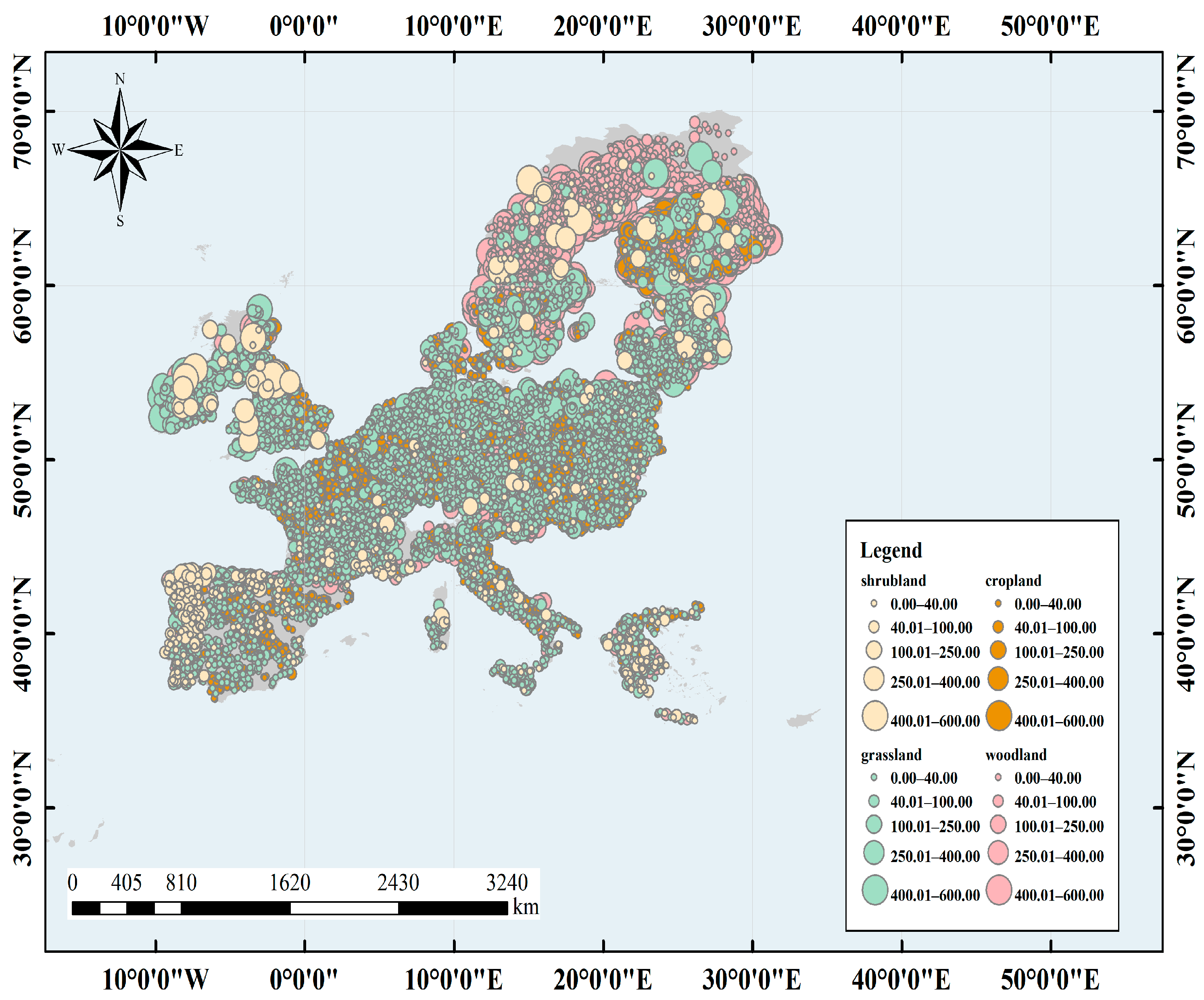
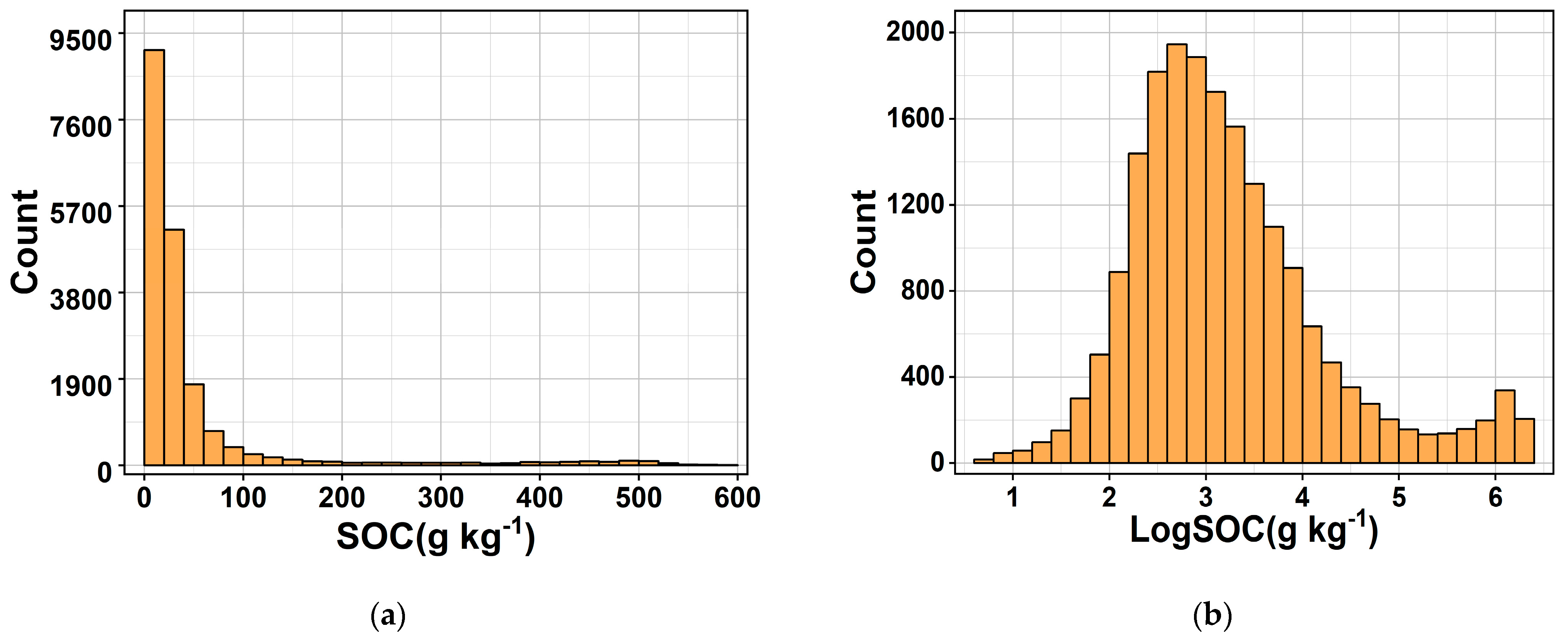



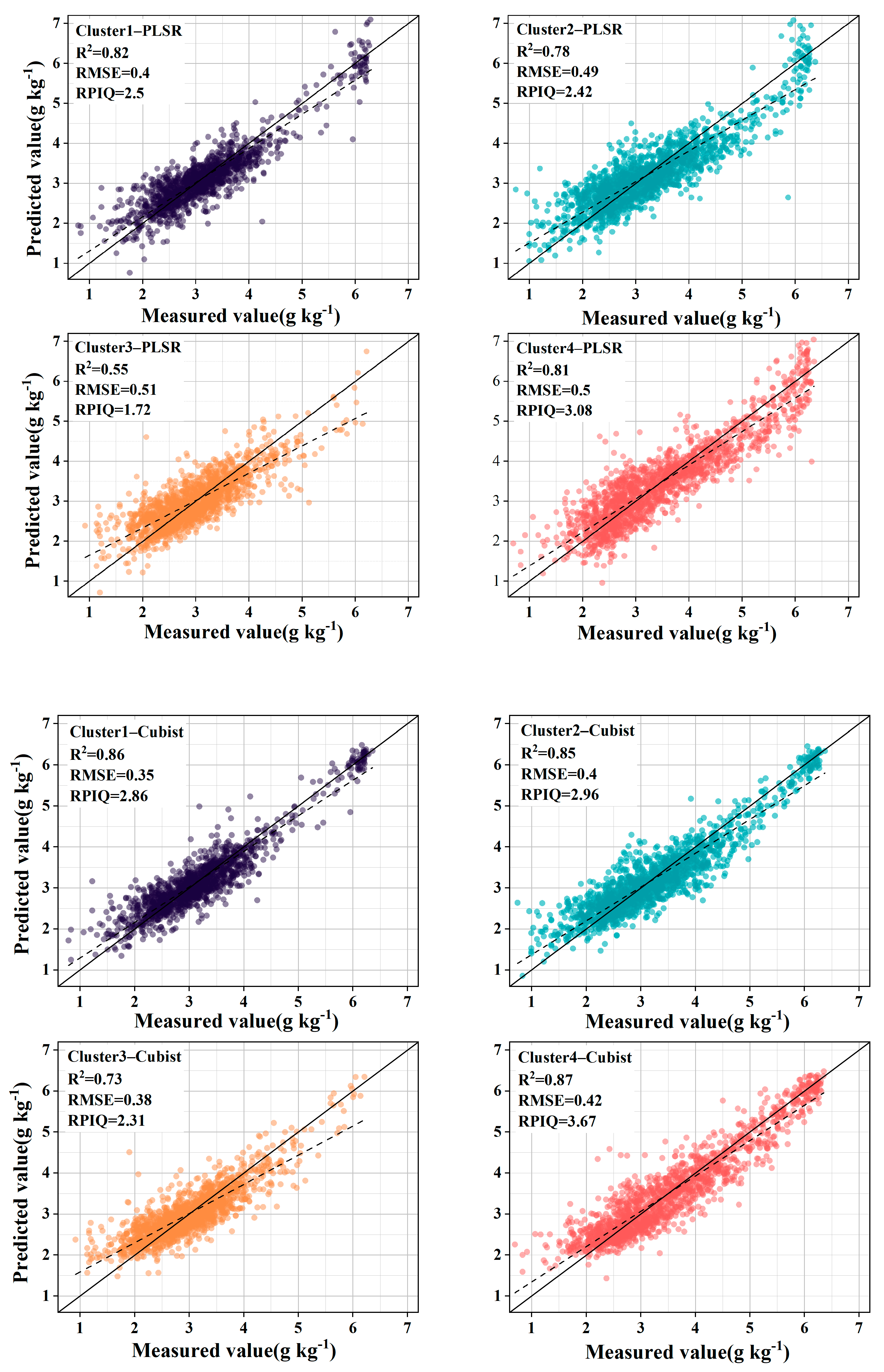
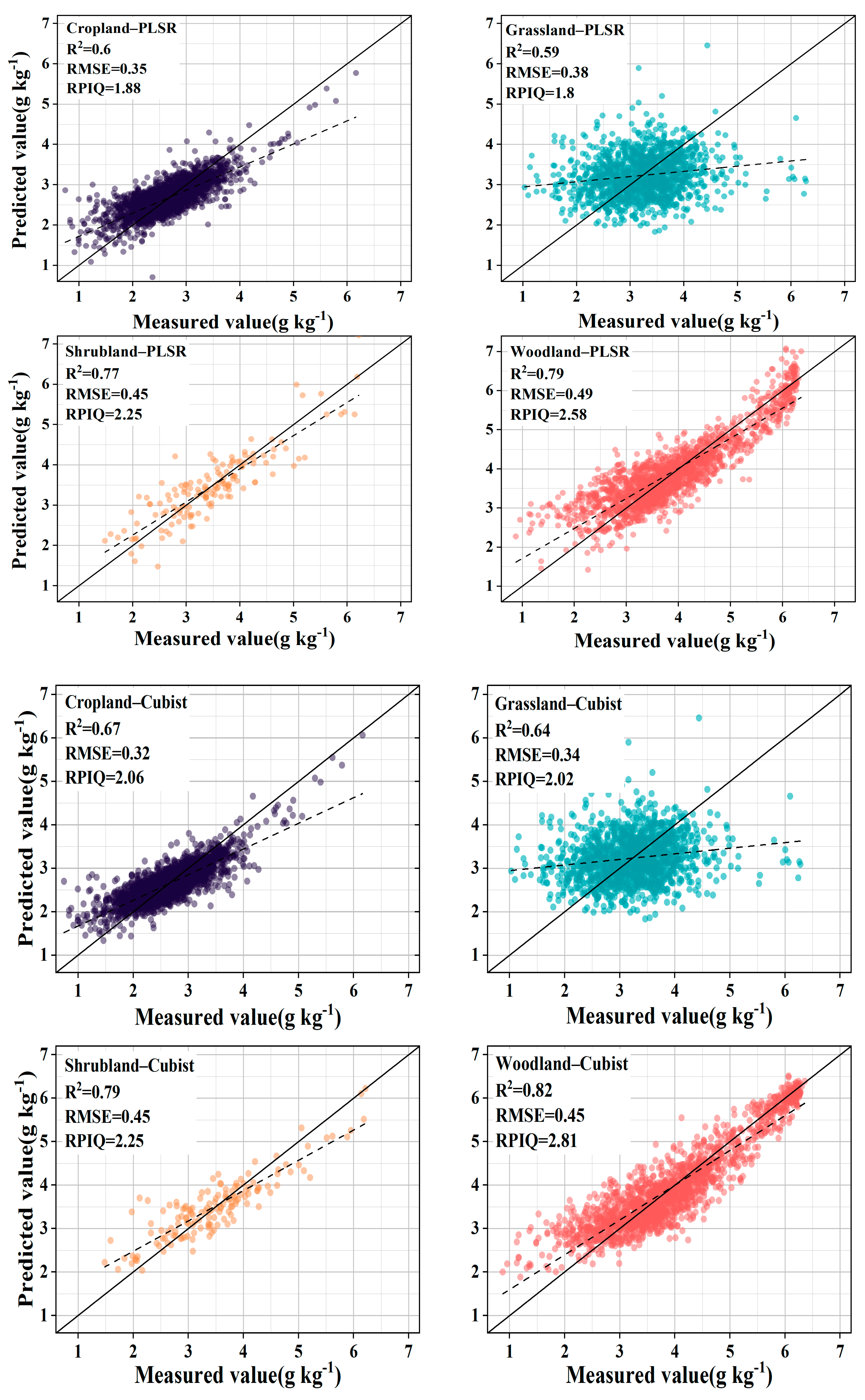
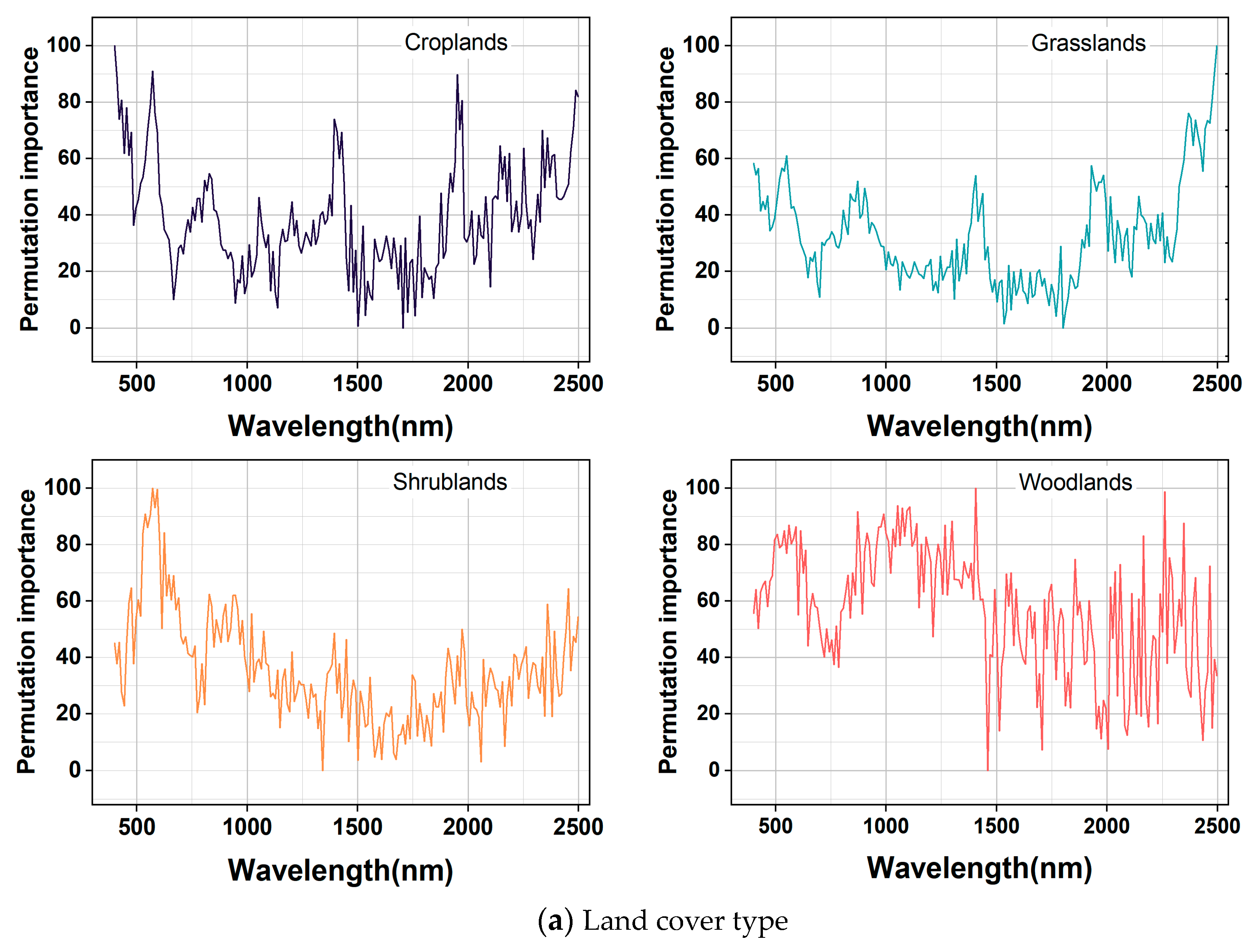

| Subsets | N | Cubist | PLSR | ||||
|---|---|---|---|---|---|---|---|
| R2 | RMSE | RPIQ | R2 | RMSE | RPIQ | ||
| All | 18,921 | 0.75 | 0.33 | 2.5 | 0.72 | 0.35 | 2.36 |
| Cluster1 | 3870 | 0.86 | 0.35 | 2.86 | 0.82 | 0.4 | 2.5 |
| Cluster2 | 4914 | 0.85 | 0.4 | 2.96 | 0.78 | 0.49 | 2.42 |
| Cluster3 | 5145 | 0.73 | 0.38 | 2.31 | 0.55 | 0.51 | 1.72 |
| Cluster4 | 4992 | 0.87 | 0.42 | 3.67 | 0.81 | 0.5 | 3.08 |
| Mean | 4730 | 0.83 | 0.39 | 2.95 | 0.74 | 0.48 | 2.43 |
| Subsets | N | Cubist | PLSR | ||||
|---|---|---|---|---|---|---|---|
| R2 | RMSE | RPIQ | R2 | RMSE | RPIQ | ||
| All | 18,921 | 0.75 | 0.33 | 2.5 | 0.72 | 0.35 | 2.36 |
| Cropland | 7476 | 0.67 | 0.32 | 2.06 | 0.6 | 0.35 | 1.88 |
| Grassland | 4200 | 0.64 | 0.34 | 2.02 | 0.59 | 0.38 | 1.8 |
| Shrubland | 443 | 0.79 | 0.45 | 2.25 | 0.77 | 0.45 | 2.25 |
| Woodland | 5218 | 0.82 | 0.45 | 2.81 | 0.79 | 0.49 | 2.58 |
| Mean | 4334 | 0.73 | 0.39 | 2.29 | 0.69 | 0.42 | 2.13 |
Disclaimer/Publisher’s Note: The statements, opinions and data contained in all publications are solely those of the individual author(s) and contributor(s) and not of MDPI and/or the editor(s). MDPI and/or the editor(s) disclaim responsibility for any injury to people or property resulting from any ideas, methods, instructions or products referred to in the content. |
© 2024 by the authors. Licensee MDPI, Basel, Switzerland. This article is an open access article distributed under the terms and conditions of the Creative Commons Attribution (CC BY) license (https://creativecommons.org/licenses/by/4.0/).
Share and Cite
Miao, Y.; Wang, H.; Huang, X.; Liu, K.; Sun, Q.; Meng, L.; Xu, D. Soil Organic Carbon Prediction Based on Vis–NIR Spectral Classification Data Using GWPCA–FCM Algorithm. Sensors 2024, 24, 4930. https://doi.org/10.3390/s24154930
Miao Y, Wang H, Huang X, Liu K, Sun Q, Meng L, Xu D. Soil Organic Carbon Prediction Based on Vis–NIR Spectral Classification Data Using GWPCA–FCM Algorithm. Sensors. 2024; 24(15):4930. https://doi.org/10.3390/s24154930
Chicago/Turabian StyleMiao, Yutong, Haoyu Wang, Xiaona Huang, Kexin Liu, Qian Sun, Lingtong Meng, and Dongyun Xu. 2024. "Soil Organic Carbon Prediction Based on Vis–NIR Spectral Classification Data Using GWPCA–FCM Algorithm" Sensors 24, no. 15: 4930. https://doi.org/10.3390/s24154930




